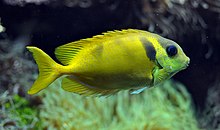| Neopterygii Temporal range:
| |
|---|---|

| |
| Siganus corallinus (a teleost) | |

| |
| Lepisosteus oculatus (a holostean) | |
| Scientific classification | |
| Domain: | Eukaryota |
| Kingdom: | Animalia |
| Phylum: | Chordata |
| Class: | Actinopterygii |
| (unranked): | Actinopteri |
| Subclass: | Neopterygii Regan, 1923[1] |
| Infraclasses | |
|
For others, see text | |
Neopterygii (from Greek νέος neos 'new' and πτέρυξ pteryx 'fin') is a subclass of ray-finned fish (Actinopterygii). Neopterygii includes the Holostei and the Teleostei, of which the latter comprise the vast majority of extant fishes, and over half of all living vertebrate species.[2] While living holosteans include only freshwater taxa, teleosts are diverse in both freshwater and marine environments. Many new species of teleosts are scientifically described each year.[2]
The potentially oldest known neopterygian is the putative "semionotiform" Acentrophorus varians from the Middle Permian of Russia;[3][4] however, one study incorporating morphological data from fossils and molecular data from nuclear and mitochondrial DNA, places this divergence date at least 284 mya (million years ago), during the Artinskian stage of the Early Permian.[5] Another study suggests an even earlier split (360 myr ago, near the Devonian-Carboniferous boundary).[6]
| Vertebrates |
| |||||||||||||||||||||||||||||||||||||||
- ^ Regan, C. Tate (1923). "The Skeleton of Lepidosteus, with remarks on the origin and evolution of the lower Neopterygian Fishes". Journal of Zoology. 93 (2): 445–461. doi:10.1111/j.1096-3642.1923.tb02191.x.
- ^ a b Nelson, Joseph, S. (2016). Fishes of the World. John Wiley & Sons, Inc. ISBN 978-1-118-34233-6.
{{cite book}}: CS1 maint: multiple names: authors list (link) - ^ Broughton, Richard E.; Betancur-R., Ricardo; Li, Chenhong; Arratia, Gloria; Ortí, Guillermo (2013-04-16). "Multi-locus phylogenetic analysis reveals the pattern and tempo of bony fish evolution". PLOS Currents. 5: ecurrents.tol.2ca8041495ffafd0c92756e75247483e. doi:10.1371/currents.tol.2ca8041495ffafd0c92756e75247483e (inactive 1 November 2024). ISSN 2157-3999. PMC 3682800. PMID 23788273.
{{cite journal}}: CS1 maint: DOI inactive as of November 2024 (link) - ^ "PBDB". paleobiodb.org. Retrieved 2024-02-26.
- ^ Hurley, Imogen A.; Mueller, Rachael Lockridge; Dunn, Katherine A. (21 November 2006). "A new time-scale for ray-finned fish evolution". Proceedings of the Royal Society B. 274 (1609): 489–498. doi:10.1098/rspb.2006.3749. PMC 1766393. PMID 17476768.
- ^ Thomas J. Near; et al. (2012). "Resolution of ray-finned fish phylogeny and timing of diversification". PNAS. 109 (34): 13698–13703. Bibcode:2012PNAS..10913698N. doi:10.1073/pnas.1206625109. PMC 3427055. PMID 22869754.
